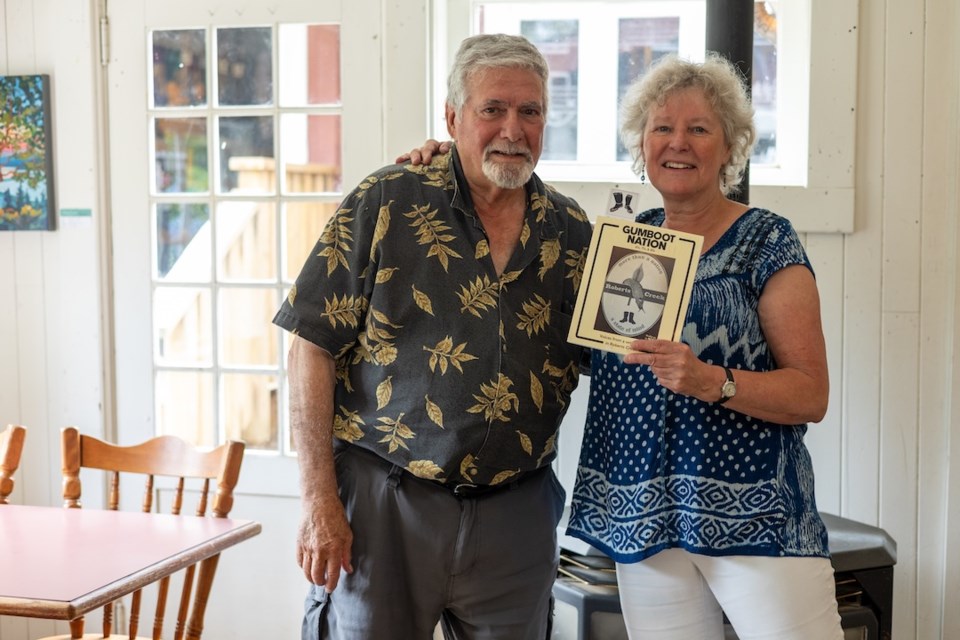Nearly half a century after the first history of Roberts Creek chronicled the community’s transformation from pastoral preemptions to thriving coastal enclave, a new book tracks the Creek’s course through the transformative ‘60s, ‘70s and ‘80s.
Ed Lands and Anne Moul released Gumboot Nation: Voices From a Unique Era in Roberts Creek last week. Just don’t call it a history — at least not within earshot of Lands. “I wanted personal stories,” said Lands, who moved from Montreal to the Sunshine Coast in 1973. “I didn’t want someone’s recollection of something that happened over there. You may as well write a history book and I wasn’t interested in that. So I got as personal a story as I could from people.”
Lands credits the pioneering work of Creek storytellers like King Anderson (who entrusted recollection-filled monographs to the Roberts Creek Community Library in the mid-1980s) and longtime Coast Reporter columnist Hugh Macauley. In 2018, Macauley and Lands defined their vision for the project: to bring together various communities within the community of the Creek. After Macauley died in 2022, Lands brought the work to completion with the support of Anne Moul as transcriptionist and editorial consultant.
“Hugh gave me enough inspiration to think that I should keep moving on this, keep pushing away at it,” recollected Lands, pointing at the table in the Gumboot Café where he and Macauley met regularly. “I would just keep putting it out there and do a few interviews, and the odd interview was transcribable.”
The volume is illustrated, family album-style, with photographs imbued with the warm patina of pre-digital collegiality. The cover graphic — the logo of the erstwhile Coast Family Society, whose fate is outlined in a story submitted by Bob Wiley — bears the Creek’s unofficial coat of arms: a slug, a skunk cabbage, and a pair of gumboots.
In conducting interviews and soliciting submissions, Lands started with a common question: how did each Creeker arrive? The origin stories, woven together, form a mosaic depicting a countercultural community with cosmopolitan roots. “Thank heaven for the hippies,” writes Judi Scott-Wood, who migrated her five-member family from the Côte d’Azur to the Creek in 1969. “Their colourful lives and personalities were just starting to move into town to brighten our lives.” Diana Morgan recollected the intoxicating vibes of the Goon Saloon — situated in the community’s commercial centre — and the communal kitchen at Crowe Road, where homemade beer was brewed in prodigious quantities.
“Roberts Creek was, and still is, a real hotbed of interesting people,” observed Lands. “They’re very alternate thinkers, very strongly-minded people. Another theme [of the community] is draft dodgers, of which there was a big influx.” Not everything was sedate: Jeannie Parker details the 1976 murder of Billy Black, which triggered an international manhunt for the culprit. John-John Morris describes a shootout at the ill-fated Peninsula Motor Inn with all the flair of a Louis L’Amour western.
The demands of rural life were occasionally backbreaking (“we made our own soap, we spun our own wool, and carded,” remembers Diana Morgan), but the rewards were great — particularly the abundance of musical collaboration. Meanwhile, the evolving physical landscape is spotlighted in accounts like Carolann Glover’s chapter, which documents the development of the Roberts Creek pier. A decade-long effort to remove hulking propane tanks and increase waterfront accessibility culminated in 1994. “The pier was transformed,” said Glover, “into the sacred space we know today.”
“Today, [Roberts Creek] has become a little less alternate overall,” said Moul. She used her editorial pen lightly, aware of Lands’s desire to preserve the authenticity of the book’s first-person narratives. “But there’s lots going on — like the mandala project, which is actually a relative newcomer from our perspective. Things like that keep happening, attracting new people. It just keeps percolating.”
Profits from sales of Gumboot Nation will benefit the Roberts Creek Community Association. Copies are for sale ($25) at the Roberts Creek Community Library, the Gumboot Restaurant, Eco-Feako, Talewind Books in Sechelt and the One Flower One Leaf gallery in Gibsons.
“We look like a tiny odd place,” writes Lia Lands Atebi in the poem that concludes Gumboot Nation, “but just watch us.”



